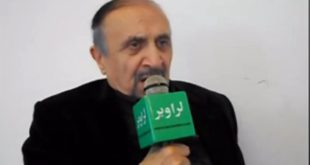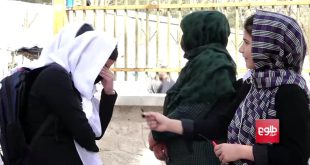By Dawood Azami
BBC Persian and Pashto
The second front in the conflict between the Taliban and their enemies in government is the war of words – and in recent months that battle has intensified.
The Taliban have a sophisticated public relations machine which is making it harder for governments and their international allies to win the ever-important propaganda war.

The insurgents are keen to exploit a sense of alienation among people, fostered by “bad governance” and “mistakes” made during military operations.
Civilian casualties in American air strikes and the violation of local traditions including house and personal searches create an atmosphere where Taliban propaganda can take root.
Afghan political commentator, Rostar Tarakai, says that it is the simplicity of the Taliban’s message that makes it most effective.
“They talk about occupation, they highlight the fact that foreign troops are killing Afghans and raiding their homes – and it works,” says Mr Tarakai.
Taliban calling
The insurgents use audio and video recordings, flyers and handouts, so-called “night letters” [letters with warnings or messages posted overnight], newspapers, journals and magazines as well as books.
Radio and television broadcasts are the militants’ main tools to spread their message and glorify their achievements.
The Taliban and their sympathisers have FM radio stations in Pakistan broadcasting anti-US propaganda.
Although the Taliban banned television when they were in power in Afghanistan (1996-2001), they now use video recordings containing messages and footage of their attacks on foreign and local security forces.
Some of this footage also finds its way to Youtube and other internet sites.

Mobile phones are also used to threaten and intimidate local adversaries and spread anti-US and propaganda material in the form of text messages and short video clips.
Taliban anthems are even used as mobile phone ring tones in some areas.
At the other extreme it is not uncommon to see Taliban supporters simply talking at social gatherings or informal meetings in an effort to vilify the local governments and their allies.
‘Virtual’ sanctuaries
Insurgents have been using the internet very skilfully.
Their websites (in Pashto, Dari, Urdu, Arabic and English) are regularly updated with battlefield reports as well as statements by their leader, Mullah Muhammad Omar, and other commanders.
The publishing office of the Islamic Emirate in Afghanistan (the name the Taliban use for their regime) recently started publishing an account of their “successes and achievements” on their own media outlets “in order to inform the compatriots and the world public”.
“The Taliban have changed their tactics and try their best to portray their struggle in a positive way and to make their actions seem acceptable or laudable to audiences,” says Dr Hamid Hussain, a New York-based security expert.
Soon after an attack a Taliban spokesman contacts local journalists.
E-mails and mobile text messages are generally used to issue press releases to inform journalists of their activities.
“The Taliban are generally the first to tell us about incidents and then we check with foreign or local security officials,” says Abdul Wadood Hejran, a journalist from southern Afghanistan.
“We also call these spokesmen on their mobile telephones when we need more information or want to find out about their version of an incident,” adds Mr Hejran.
Songs and poems
But perhaps the greatest weapons are the mass-produced and emotionally charged Taliban propaganda CDs and DVDs which can be easily bought in shops in Afghanistan and Pakistan.
They feature propaganda ranging from rousing speeches to pro-Taliban songs and poems and footage of destruction caused by the allied military operations.
They also show disturbing images of civilians, including children and women said to have been killed in aerial bombardments and alleged spies “confessing” before they are killed.
They are aimed at potential sympathisers and to arouse passions in Afghanistan and Pakistan as well as Muslims outside the region.
The Pentagon has reportedly launched a broad “psychological operations” campaign to counter the Taliban advances in the propaganda war. It includes taking down their websites and jamming radio stations.

The Taliban reacted angrily, calling it a “cowardly act” and an “infringement of the same freedom of expression that the US boasts”.
State-owned media, both in Afghanistan and Pakistan, have their own ways to counter the Taliban propaganda.
The terminology used has a propaganda value of its own.
The governments in Afghanistan and Pakistan and their foreign allies describe the insurgents as “terrorists”, “miscreants”, “enemies of the people” and “enemies of the country”.
While the Taliban try to discredit the local governments and their allies by calling them “infidels”, “invaders”, “traitors”, “collaborators”, “corrupters”, “puppet regime” and “traitor government”.
“Some people in certain areas might become easy prey to insurgents’ propaganda because there is a feeling of disenchantment,” says Ali Ahmad Jalali, a former Afghan interior minister who is now a professor at the US National Defense University in Washington DC.
“But the overwhelming majority of Afghans don’t want the return of the Taliban regime,” adds Mr Jalali.
The propaganda fight is intense because whoever wins it will gain the support of the people and stands a chance of winning the war on the ground too.
Story from BBC NEWS:
http://news.bbc.co.uk/go/pr/fr/-/2/hi/south_asia/8176259.stm
Published: 2009/08/03 07:03:53 GMT
Taliban slick propaganda confronts US
Shops in Pakistan stock Taliban propaganda alongside Indian movies.
A Kandahar “night letter” tells public servants not to work with the government.
Taliban propaganda ranges from text messages to magazines
 لراوبر ویب پاڼه لراوبر يو افغان – تازه خبرونه
لراوبر ویب پاڼه لراوبر يو افغان – تازه خبرونه


